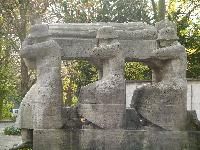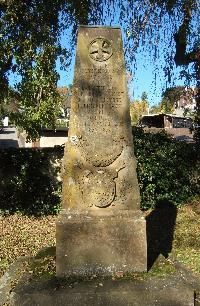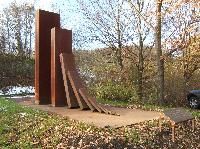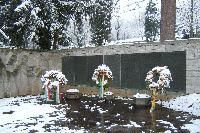 The Korean War memorial shown here (left) is in the form of a sundial. What does that mean?
I honestly don't know.
The Korean War memorial shown here (left) is in the form of a sundial. What does that mean?
I honestly don't know.

Mark R. Hatlie
All the images are linked to more photos and information on the markers shown. Click on the image to go to the marker page.
Most all of us are caught unprepared by monuments and memorials, if we notice them at all. Either we stop and view a roadside historical marker, or visit an obelisk or statue in some city we are visiting (we rarely pay any attention to those near where we live, at least not where I live, here in Europe, where they are among places people actually go and not off on the edge of town like is often the case in the U.S., at least in the western half of the country). We don't usually go to markers which refer to things about which we are well informed. Whether our visit is intentional or by chance, we rarely have taken the time beforehand to study up on the events concerned. The monument or memorial then, has a virtual monopoly on our understanding of the events and people it refers to: We simply don't know anything about the guy up on the horse or the name or the date on the plaque. Whatever the monument says, that is what we know at the time of our visit. Unless the events or people refered to spark our interest in an unusual way and we go off and do more research, the marker's story is likely to maintain its monopoly on our knowledge for the future as well. If there is any more information about the theme of the marker nearby, such as in a giftshop or tourist information center, it will almost certainly confirm the impression given by the marker and will rarely tell you anything about the marker itself.
The image here of the man on the horse shows a monument in downown Stuttgart. Hundreds of people undoubtedly walk past it everyday without paying any attention to it. Those who do stop and take notice probably can't put it into its historical context very well. It shows the dates 1870-1871 and gives the names of French towns and dates. Those are the dates and battles of the Franco-Prussian War - but the monument doesn't say so.
As tourists living in or visiting our historical landscape, we simply don't have the resources to overcome this problem. We cannot read two competing biographies of every memorialized hero we encounter or read old newspapers about the events concerned. We don't have the time and simply aren't that interested most of the time. But does that mean that we surrender the field to these brass and granite representations?
We don't have to. And not giving in can make our stops at historical sites, monuments, markers and memorials a bit more interesting if we have learned to deconstruct them. By this I do not mean that we should always carry a hammer and wheel barrow and turn them into dust. I mean we should learn to practice taking one step back and viewing the marker itself as the object of interest. The events to which the marker refers come second. We ignore or put off the memorial's call to remember some event and instead focus on the memorial. (The choice of the term "deconstruct" in this context is arguably somewhat unfortunate. "Deconstruction" carries a lot of academic baggage I did not intend to bring on board when I first titled this essay.)
This can be especially fun if we do know something about the events concerned, but are new to the memorial or its history. A common situation is that the marker is a vague, all-encompassing reminder of something we know something about. For example, the town might have a World War Two or Civil War marker. We know something about those wars - from books, from family stories, from movies and TV documentaries. The memorial doesn't seem to tell us more in terms of facts. Here, we are simply reminded that the war happened and given a brief glimpse into its local repurcussions. Perhaps the memorial lists the local dead. Or perhaps the memorial is dated, giving us a clue as to when the town finally got around to memorializing it. That tidbit is how we begin to "deconstruct" the memorial.
There are several ways to deconstruct a marker (the word I will use to cover all historical representations in the landscape, be they historical markers, historical sites, museums, statues, memorials, cemeteries, or whatever). The viewer can start with a "naive" viewing or "consumption" of the marker first. Then he or she can proceed to think about what the marker is trying to convey, and then consider who may have built it, who may have funded it, what has been left out, etc. The order in which these questions are considered is less important. So please consider the following list as a collection of ideas and not as a roadmap or step-by-step guide. Often, knowing the answers to many of the questions will be impossible without doing further research. It is my hope that by learning to ask these questions and ponder possible answers, however, we can change the way we see these markers into a way that makes visiting them both more interesting and more fun. Maybe next time you walk past a marker, you'll stop and take a closer look at it. And if and when we do have time to actually research a monument before or after visiting it, all the better.

Historical markers create a link between three different situations. First, there is the event or person to which the marker refers, say a military battle. Then, there is the building of the marker. Then there is now - you standing in front of the marker and "learning" from it. In a sense, the marker creates more than a "link," it creates communication over time and sometimes over space, depending on where the marker stands relative to the historical locations of the events memorialized. The distances in time and space can be very great or very small. All three of these layers or situations have a wider context which is important for the marker.
In essence, all that follows below is about being aware of all three stages. In other words, a marker about the "Little Bighorn Battlefield" is only partially about the Battle of Little Bighorn. It is also about the people who put up the marker after the battle was long over and you, the person visiting it now, more than a century after the battle. Most of the questions aim at the second stage - when the marker was built - or at the third stage, the present. That is perhaps why this process is called "deconstruction." It is subversive. The marker, after all, was ostensibly put up to get you to think about the first stage. The whole trick is uncovering what it wants you to think, of course.
Some memorials and monuments consciously connect several layers of the past. The memorial pictured here is a typical German war memorial in that it was originally built to honor the fallen of World War One, but was later expanded to include the Second World War as well. After 1945, the people of the town returned to the same location to expand the former memorial instead of constructing a new one.

Who built it?
Does the monument say who built it? Many markers, such as the memorial shown here for German refugees, actually have information about the designers, builders and dedicators of the marker chisled into them. If so, what can you say about those people? Which section of society did they represent? What was their status or position in society? Does the marker reflect that status? Can you make some guesses about the people based on the marker itself? Who would invest the time and money back then into a marker like this?
Is there any indication of who actually funded the marker? Often, private groups or individuals have an idea for a monument and take the initiative, but much of the money ends up coming from other sources, such as the government. How may the funders of the marker have been pursueded to fork out the funding?
When was it built?
This is closely related to the last question, of course. Does the marker reflect the period in which it was built? There are several ways in which it might do so.

On the surface, there is the artwork or style of the marker. Soviet memorials are often recognizeable at a glance, even without their red stars and flags, because of the way they portray the human form. 19th century monuments often show a preference for ancient Greek and Roman classical style. The Franco-Prussian War memorial shown here, for example, shows crossed Roman-style swords. There are also examples of Greco-Roman helmut designs adorning World War One gravesites, for example, at the Stuttgart military cemetery
But the time the marker was built is also important with reference to the last question, about the people who built it and their role in society. What were the important issues of that period with regard to the events refered to in the marker and what might the people who built it have wanted to say? What were, in short, the "ideological needs" of the sponsors at that time? As Loewen shows in his book, Civil War monuments have varied over time and transport the opinions of when they were built more than any "facts" about the Civil War. The same Stuttgart military cemetery just mentioned shows a marked contrast between the German society of the early 1920s and that of the late 1940s, early 1950s. The cemetery clearly shows how the attitudes toward war and remembrance were as different as night and day.
There is often information about the creation of the marker on the marker itself. War memorials often list donors who helped fund it, politicians who advocated it or unveiled it, etc. That information can play into your thinking about the actual function of the memorial: Was it a community project? A political project? A business venture?
What is the message of the marker?
This is a very complex question and it overlaps with the others in many ways.

Are there overt ideological indicators on the marker such as communist or Christian symbols? Are there overt symbols which you might have expected, but are missing (such as no cross on a memorial for a dead person?) In Germany, groups of three crosses, reminiscent of Golgotha, are common at military cemeteries. This example is from the buriel site for Nazi victims in Tuebingen.
Often, there is text on the monument that is explicit and clear or intentionally vague. In Germany, where the cultures of memory were so different after the two world wars, it is common to have an explicit message with a complete list of the fallen dating to the period after World War One and a vaguely worded plaque added on for the Second World War from the postwar period.
Do the images on the marker convey subtle messeges and can they assumed to be intended by the sponsors? Assume the answer is to both questions is "yes" and look for clues. If there are human figures, are they "doing" anything? Who is doing what? How are they portrayed? How are issues of gender, class, race and age reflected in the people depicted in the marker?
What is the didactic element of the marker? Put another way, does the marker explicitely or implicitely want to teach the target audience something or encourage a particular behavior? For example, often war memorials are interpreted as encouraging the next generation to be willing to go to war or to instill respect for the older generation's sacrifice.
Often for any major event like a war there is a "dominant narrative" or version of history that is mainstream or official. It covers the reasons the war was fought, the just nature of how it was fought, and the reasons why the sacrifices demanded were worth it. Does the marker you are looking at conform to this "dominant narrative"? Does it contradict or ignore that narrative?
 The Korean War memorial shown here (left) is in the form of a sundial. What does that mean?
I honestly don't know.
The Korean War memorial shown here (left) is in the form of a sundial. What does that mean?
I honestly don't know.
Who is the marker for?
This is not always as obvious as it seems. Often, the text on the marker will be explicit about who is included. Many German memorials, for example, are for the fallen soldiers. Some of them appear to be for the soldiers - they show a soldier figure, for example - but also list the names of civilians who were killed during the war.
A related question is about perpetrators. Markers memorializing tragedies can mention the perpetrators, or leave them out. This site has a memorial plaque for the gypsies killed by the Nazis which explicitly mentions the killers, although not by name.
Why is the marker here?

For many markers, this will be easy. The marker is here because the event to which it refers happened here. But sometimes it is not that easy. Lincoln's supposed log cabin got rebuilt and moved. Thoreau's Walden cabin is not at the original location. Some people get statues who never came near the places their statues stand in (Columbus is very good at this). And for large events, the marker has to be put somewhere: Where the general stood or where the troops were dying? Which troops? Or is it because it was easier to build the access road here? Sometimes, markers may have been put up to ideologically "occupy" certain disputed spaces, even if those spaces started out without any particular significance of their own. The Russian Empire for example, used to build Russian Orthodox churches near the city centers of major cities in their empire, even when there was hardly any Orthodox population to use them. They were symbolically occupying down-town real-estate for the message: This is Holy Russia.
The memorial shown here is an example of both a vague message - there is little indication at the memorial itself that it is a memorial for German deserters who were executed by the Nazis - and an interesting location. It was first set up in the downtown part of a large city. Then the city council had it removed. It then spent years on private property, in a lady's yard, before it was put up on the side of a road outside of town. But the location is near a site where deserters were executed. But nothing on the memorial tells that story.
Who is the intended audience of the marker?
Of course most markers are assumed to be visible to anyone walking by. But think more about that. There is the question of location, of course, considered above. If the location is not dictated by the events or people refered to in the marker, a battle site or birth location, does the site chosen reflect a target audience?
Does the marker "speak" to a specific audience or leave audiences out? That inclusion might be linguistic: Is there text in Spanish? More subtly, are there "visitor constituencies" who are being glorified? Villified? Ignored? Sometimes the very name of an historical site already gives clues to the ideological background and the circle of people that the marker is intended to speak to. The Little Bighorn Battlefield used to be called "Custer's Last Stand". Do you see the difference? Are Amerindians included among the circle of people likely to visit the site?
This memorial marker is outside a small German town, but it is in French. It commemorates the deaths of three French soldiers in 1945 and is associated with an ugly incident between the town and the French army. But nothing on the marker appears to be targeted at the local community. They can't even read it.
Does the marker still "function"?

This is the interesting question about the current social purpose of the marker. Obviously, since you are visiting the marker, it is not totally forgotten. But are you the only one there? Do the locals pay any attention to it, or only the pigeons? Do they care for the marker? (Who funds the maintainance?) Is the marker the scene of any "rituals" such as wreath layings at anniversaries? Are there fresh flowers or recent candles there now?
War memorials can be divided into those which are strictly symbolic - they are strictly memorials like obelisks, statues, plaques, etc. - and those which are utilitarian, i.e., those that have a function such as being a community building, a stadium, a park or something. Those who oppose utilitarian memorials argue that this second use makes people quickly forget that it is in fact a memorial. If you are looking at a utilitarian memorial, ask yourself if it is still a memorial at all. Has it completely lost its commemorative function or is it more than just a ball park?
The memorial section of the Muehlacker/Enz cemetery shown here on the right is typical. Every November, wreaths are presented at war memorials all over Germany. The city presents a wreath, and sometimes the local association of war victims does as well. In the case shown here, however, the local Italian community also presented a wreath of its own!

The photo here (left) of a cemetery for the fallen of World War One was taken right after the German memorial day. It shows that there were people drinking at about the time of the wreath-laying. Champagne?
Does the marker serve the social purpose for which it was probably intended?
If the marker is obviously no longer in "use", it is interesting to contemplate why not. Is it simply the case that markers in general don't work as being constant reminders of whatever it was they supposedly remind us of? Are they, finally, futile? Or do they, in the end, really serve another function - that of disposing of history? What I mean is this: Can we pour history into a concrete obelisk and be done with it? After all, we have done our duty and preserved it. Now we can move on. This idea was a major factor in the debates surrounding the German Holocaust Memorial which was, after 17 years of discussion, finally dedicated in 2005. Some of those who opposed the monument did so not because they didn't like the design or because they didn't want the Holocaust remembered, but because they didn't want the discussion to end! They were afraid that a monument would be a way to set historical memory aside.
In the case of markers set up to represent events that never happened (such as this example from Idaho) or people that never existed (such as Confederate fallen from Montana, an example from Loewen's book), it is more a case of markers creating history than archiving it, of course.

The military cemetery in Riga shown here was built by the state to commemorate the fallen of the First World War and Latvian War of Independence. It is still used for national memorial ceremonies.
The new Holocaust memorial in Berlin (offsite link), which was was preceded by 17 years of discussion and rancorous debate, had hardly been up for a month when reports started coming in that visitors were not showing the proper piety. They were playing hide-and-seek among the pylons, making out, sitting down, etc.
Has the target audience died off? Or is the message that the marker conveys outdated? Or is it simply uncomfortable and people would rather not think about it? Be careful with that last answer. Are war memorials to fallen heroes really ignored because people don't want to honor the fallen? Or because they don't want to think about the horrors of war? Be hard on yourself, make it interesting and blame the monument: How and why did this war memorial fail to maintain interest in its subject?
Why is there no marker here?
This is related to the location question. Markers are not only put in certain places, but they are also not put in certain places. This is something to bear in mind in situations where you suspect there might be some really interesting history or where you know that there is some interesting history, but find no marker. During the Soviet period, there was no marker to the Riga Jewish ghetto, nor to the Riga concentration camp, nor to the location south of Riga where more than 20,000 Jews were shot. But there was a huge memorial ensemble built at another concnetration camp near Riga at Salaspils. The Soviet regime wanted certain victims and events remembered, and others not, and the locations as well as the themes emphasized in the monument reflect that.
The point of this whole essay is, in a nutshell, to get you, the visitor to an historical marker, to question the marker and not accept, passivly and without even being aware of it, some intended or unintended "message" offered by that marker. People who build markers do so with intent. Think about that intent. Markers occupy overlapping and complex places in history, not just places in public space. They become most interesting when we actively consider that space.
This is not meant to be cynical. We are looking for an historical approach. By stepping outside yourself for a moment, you are not disrepecting the dead, scorning the tradition, or being impious. Think of it as engaging the monument in a dialogue.
Mark R. Hatlie Tuebingen, Germany
BACK TO TOPJames Loewen, in his fascinating book Lies Across America, gives a detailed account of how monuments come into being, the functions they serve in society, and how inaccurate they often are. His examples, as the title implies, all come from within the United States. His ideas, however, apply to historical markers everywhere. At the end of the book, he gives a list of "Ten questions to ask at an historical site", also available at his webpage. I have modified that list here and given some more detail than he does in his short list. But many of the ideas I use here are also from the more detailed introductory chapters of that book. Anybody interested in a detailed account of the "sociology of historic sites" (how they are made and received) or "the function of public history" should read his account in the opening chapters of his book and the over 100 detailed examples which fill the rest of Lies Across America.
Other literature I would highly recommend for investigating "cultures" of memory, especially with regard to memorializing military conflict, include the following books, from which I have also drawn ideas:
For more literature, see the growing list of titles at the resources page.